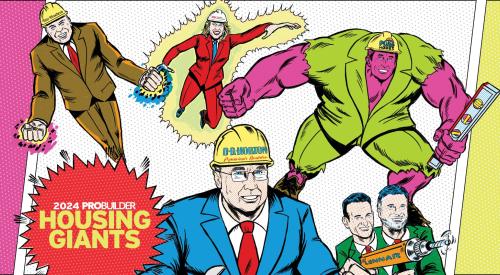 |
|
Masters of the Universe (Giants 6-13) all have $1 billion or more in revenue, which should produce strong purchasing power. Yet the average house cost breakdown shows a higher materials cost percentage than that of the Rich and Famous (Giants 23-135). Still, Masters do have the highest average profit (16.0 percent). |
 |
|
Rich and Famous (Giants 32-135) includes builders with revenue from $200 million to $991 million. While average profit is lower than that of the Masters of the Universe, and labor costs are higher, somehow materials costs are a fraction lower. |
 |
|
Achievers (Giants 135-282) are builders ranging from $75 million to $199 million in revenue, many with multiple market operations. Still, the average home in this group yields a profit of 10.4 percent —well below the 16 percent average for Masters of the Universe. |
 |
|
Strivers (Giants 283-400) include builders with revenue of $14.6 million to $74.6 million, the lowest level of purchasing power among all Giants. Not surprisingly, profit averages in single digits, and materials costs are nearly 30 percent. |
Peruse the average cost and profit charts to the right and you'll see a general trend that's consistent, year after year. Profitability seems to correlate to size. It works that way across a large statistical sample, but this magazine also has a long history of documenting high profit performers at every imaginable level of production.
"We do a Cost of Doing Business survey every year," says PB contributor Emma Shinn, " and high profit companies come in every size, from different geographic markets, and build at many price points. The common denominator is good management, not whether the company is big or small, public or private."
Even though public builders are more profitable today than ever before, many private Strivers (Giants 283–400) are quietly beating the publics' EBIT margins, even if only their bankers and the IRS know it. So before reading much into the way profit on an average house correlates to builder size, keep in mind the vagaries that creep into averages. For instance, the largest Giants are in the smallest group. The Masters of the Universe has only 26 builders, while each of the other groups has more than 100 builders. The Masters also has 16 public companies, some of which do not fill out the cost breakdown section completely. And we know most public companies do not separate raw land and development costs.
Still, it seems logical to find a general correlation between size and profitability. After all, that's the message public builders repeat ad nauseam on Wall Street — that size yields purchasing power and professional management that impacts the bottom line. And overall, there is a consistent pattern in this survey showing materials and construction labor costs lower for the larger builders, indicating a degree of purchasing power.
In this year's survey, profits are higher and labor costs lower for each successive category of the Giant 400, from Strivers right through to Masters of the Universe (Giants 6–31) But there's an anomaly: the Masters average for materials costs (25.5 percent) is actually higher than that of the Rich and Famous (Giants 32–135). But when you get to the larger statistical samples — Achievers (Giants 136–282) and Strivers — the smallest builders have higher materials costs.
This survey's cost breakdowns also do not conform precisely to PB columnist Chuck Shinn's cost ratio targets. Many private builders use those targets, though, and answer the questions as they understand Shinn's ratios.
Shinn disciples also adhere to his principle that land should be treated as a separate profit center, so they take 30 percent or more profit from the land before transferring it to their home building operations. Thus, many of the private builders in this survey are reporting no land appreciation in their profit margins, which is certainly different from what the public companies are giving us.
In the last analysis, the nebulous correlation of size and profitability is good news for growing builders. It offers the prospect of better margins as they get bigger, as long as they continue to run a tight ship.
| View Additional 2006 Giant 400 Report Articles: |
| Topping Out or Just A Pause? |
| Publics Diversify Products |
| High-Rise Fraught with Risk |
| Public v. Private Debate Continues |
| Publics' Profits at Peak |
| Even Small Private Builders Can Compete |
| What Happens Next? |












